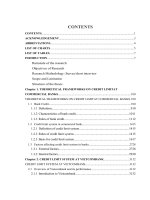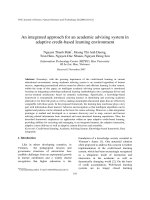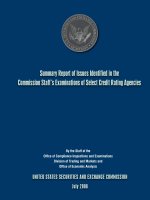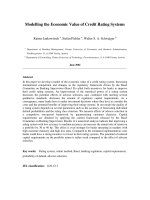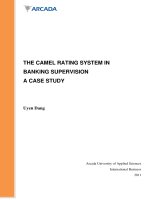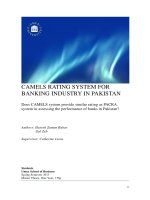Credit rating system in BDIV
Bạn đang xem bản rút gọn của tài liệu. Xem và tải ngay bản đầy đủ của tài liệu tại đây (412.93 KB, 43 trang )
NATIONAL ECONOMICS UNIVERSITY
SCHOOL OF ADVANCED EDUCATION PROGRAMS
--------
GROUP ASSIGNMENT
TOPIC: CREDIT RATING TO CUSTOMERS IN
COMMERCIAL BANKS: RATIONALITY AND ISSUES
Group: 08
Class: Corporate Finance EEP 61A
Teacher: Do Hoai Linh
Ha Noi, 2022
TABLE OF CONTENTS
A. THE OVERVIEW OF CREDIT RATING ........................................3
I. Credit risk ................................................................................................3
II. Credit rating.............................................................................................3
B. CREDIT RATING TO CUSTOMERS IN VIETNAM
COMMERCIAL BANKS..........................................................................9
I. Credit rating for individual customers borrowing capital at
commercial banks.........................................................................................9
II. Credit rating method for corporate customers at
commercial banks …………………………………………………………11
C. SITUATION OF INTERNAL CREDIT RATE SYSTEM
OF COMMERCIAL BANK IN VIETNAM (BIDV) ……………….. 13
I. Overview of BIDV ……………………………………………………..13
II. The overview of BIDV Banking Activities…………………………… 14
III. BIDV's internal credit rating principles ………………………………17
IV. BIDV Bank's internal credit scoring and rating process………………19
D. RATIONALITY AND ISSUES OF CREDIT RATING
TO CUSTOMERS IN COMMERCIAL BANKS ……………………. 31
I. Rationality…………………………………………………………….....31
II. Issue…………………………………………………………………….34
E. RECOMMENDATIONS TO COMPLETE THE CREDIT RATING
TO CUSTOMERS IN VIETNAM COMMERCIAL BANKS ………..36
I. Solution to complete internal credit rating system of BIDV Bank……...36
II. Solution to complete internal credit rating system of Vietnam………...38
REFERENCE…………………………………………………………….. .41
A. THE OVERVIEW OF CREDIT RATING
2
I. Credit risk
Credit risk usually accounts for the highest proportion in the operation of
commercial banks, so when borrowers encounter risks leading to failure to repay
their loans, it will immediately affect the capital of the bank.
The State Bank introduced the concept of credit risk in Decision
No.493/2005/QD-NHNN dated 22/04/2005: “Credit risk in banking activities of
credit institutions is the possibility of losses in banking activities of credit
institutions due to customers’ failure to perform or inability to perform their
obligations as committed.”
In other words, credit risk is the maximum total amount of money that a bank
can lose when customers fall into an inability to fulfill their committed financial
obligations. Basically, credit risk is the risk that a bank will not be able to collect a
loan when it is due.
Credit risk at commercial banks can arise due to many reasons, which can be
subjective or objective causes. Objective causes belong to external factors, these
are the causes that commercial banks themselves are very difficult to eliminate. On
the contrary, the subjective causes belong to the internal of the bank, commercial
banks can offer many solutions to limit these causes.
In order to limit risks in credit activities, commercial banks can offer many
solutions, the traditional solution commonly used is to separate the appraisal and
analysis work from the lending to ensure objectivity in credit activities, improve
the capacity of the bank's staff, strengthen inspection and supervision after lending,
etc.
Currently, commercial banks often use the results of credit rating to borrowers as a
basis for decisions related to lending, assessing loan risks, implementing customer
policies... This is a solution to advance the quality, limit credit risk.
II. Credit rating
1. History of credit rating
Credit rating is a term derived from English introduced by John Moody in
1909 in the "railway securities handbook" when conducting research, analysis and
public credit ratings for the first time for 1,500 types of bonds of 250 companies
according to a system of symbols consisting of 3 letters ABC which are ranked
respectively Aaa to C. This has become the international standard.
3
However, credit ratings only developed rapidly in the US after the economic
crisis of 1929-1933 when a series of debt companies went bankrupt or defaulted.
During this period, the US government had many regulations: prohibiting
investment institutions (retirement funds, insurance funds, reserve banks) to buy
bonds with low reliability below the level of safe investment in the credit rating.
These regulations have made the reputation of credit rating companies increasingly
high. However, for more than 50 years, credit rating was only popularized in the
US, only from the 1970s until now, has the credit rating service expanded and
developed quite strongly in many countries.
2. Definition of credit rating
We can go through some definitions of credit rating as follows:
- According to Bohn, John A writes in “Risk Analysis in Transitioning
Markets”, “Credit rating is an assessment of the ability of an issuer to make timely
payments of both principal and interest to security during its life.”
- As defined by Merrill Lynch Securities, “A credit rating is a rating agency's
current assessment of the credit quality of an issuer of debt securities, for a given
amount of debt. In other words, it is a current assessment of credit quality being
considered in a forward-looking setting, reflecting an issuer's willingness and
ability to pay principal and interest on time. The credit rating results also contain
the subjective opinions of the credit rating experts.”
- According to Moody's, “A credit rating is an opinion on an issuer's ability
and willingness to make timely payments on a given debt over the life of the debt.”
- According to the stock market dictionary, “Credit rating is the official
estimate of the creditworthiness of an individual or a company to date of its ability
to pay, including all test data, analysis, records, records. records of the
creditworthiness of individuals and business companies.”
In many countries around the world, most large companies and lending
institutions have established credit ratings for their current and future customers.
From the above definitions, we can understand as: “Credit rating of an
enterprise is an assessment of the financial capacity, current operating situation
and future development prospects of a rated corporation, from which it can be
determined the level of risk of default and the ability to repay in the future”.
4
3. Credit rating in Viet Nam
Credit rating has long been no stranger to the world. Most developed
countries in Southeast Asia have organizations operating in this field. However, in
Vietnam, credit rating is still very new and this activity is only at the beginning.
In Vietnam, there are organizations implementing credit rating, such as the
Credit Information Center of the State Bank, credit information businesses, and
commercial banks.
- Credit Information Center of the State Bank (CIC):
To provide information to commercial banks about borrowers, the State
Bank of Vietnam has established a Credit Information Center (CIC: Abbreviated
from Credit Information Center). In the first years, CIC only provided credit
institutions with customer information about the number of related credit
institutions, outstanding balances at those credit institutions, and this information
was incomplete and not up-to-date. Therefore, the significance of this information
to prevent credit risk is not high. Currently, the information provided by CIC is
more complete, including financial analysis information, the number of related
banks, outstanding balance, and status about debt, which has partly met the
requirements of credit institutions.
- Credit information corporation:
In addition to the credit information center of the State Bank and the internal
credit rating system of commercial banks to assess the creditworthiness of
borrowers, currently in Vietnam, there are only two enterprises operating in the
field of providing credit information are "Corporate Information and Rating
Company (C&V) for short", which was separated from Vietnam Solution Company
in 2004 and "Central Vietnam". Vietnamnet Credit Assessment Center (abbreviated
as CRV)” went into operation on June 4, 2006.
The main services of C&R are providing credit information, corporate credit
ratings, and market surveys by the economic sector. Meanwhile, even though the
ambition of CRV has just been born, it is not small when it claims to provide a lot
of related services such as information collection, assessment, and rating of
business norms, etc. The objects of C&V and CRV are the investors, businesses, or
the domestic and international banking system.
5
- Credit rating of commercial banks:
Currently, all Vietnamese commercial banks have built a credit rating system
(CRS) to serve internally for credit risk management and customer policy. The
CRS of commercial banks has not been unified, especially of joint-stock
commercial banks. The financial criteria in the rating system of commercial banks
are quite similar, but the non-financial criteria are much different. At commercial
banks, the CSR has different names because CSR is only a part of customer
analysis and evaluation.
4. Credit rating of Vietnam commercial banks
4.1. Overview of credit activities in commercial banks
4.1.1. Definition of bank credit:
Bank credit is a relationship of transferring capital ownership from a bank to a
customer for a certain period of time with a certain cost.
Credit relations are based on trust between the borrower and the lender. This is also
considered a prerequisite for establishing a credit relationship. And borrowers also
believe in the ability to promote the effectiveness of the loan.
4.1.2. Classification of credit:
a. According to time to maturity:
- Short-term credit: From 12 months or less.
- Medium-term credit: From over 1 year to 5 years (or 7 years).
- Long-term credit: Over 5 years (or 7 years).
b. According to the debt payer:
- Indirect credit: is a form of credit where the borrower and the borrower are
two different subjects.
- Direct credit: is a form of credit where the borrower is also the person who
directly pays the debt.
c. According to the essence of guarantee:
- Secured credit: All loans have equivalent collateral: mortgage, discount,
pledge, guarantee.
- Unsecured Credit: Loans that do not require collateral will rely solely on the
mortgage. Customers will have to ensure that they have a clear and reputable
financial position from the credibility of organizations and individuals to provide
credit capital.
6
d. According to the credit operation territory:
- Domestic credit: A credit relationship arising within the territory of the
country
- International credit: A credit relationship arising between countries or
between a country and an international financial-credit institution.
e. According to the purpose of using the loan:
- Goods production credit: For enterprises and other business entities to use
for the goods production and circulation purposes.
- Consumer credit: A form of credit for individuals to meet personal
consumption needs such as building houses, vehicles, etc.
- Study credit: Applied to students for school fees or studying abroad.
f. According to risk:
Classified by 5 groups of debts: According to Clause 1, Article 10 of Circular
11/2021/TT-NHNN
- Group 1: Qualifying debt
- Group 2: Debts needing attention
- Group 3: Sub-standard debt
- Group 4: Doubtful debt
4.2. The overview of credit rating to customers in commercial banks
4.2.1. Definition of credit rating to customers in commercial banks:
Internal credit rating is a commercial bank's assessment of the customer's
ability to repay debt, the level of risk of the loan, thereby serving as a basis for
granting credit, managing risks, and developing appropriate policies for customers
with each customer according to the ranked results.
“The internal credit system is a system consisting of:
a) Sets of financial and non-financial indicators, processes for assessing
customers' solvency and payment ability based on qualitative and quantitative
terms of finance, business situation, governance, reputation customer credit
b) Methods of assessment and rating for each group of different customers,
including those subjects to credit restrictions and their related people”.
(“According to Clause 1, Article 5 of Circular 11/2021/TT-NHNN”)
7
4.2.2. Classification of credit rating to customers in commercial banks:
The internal credit rating system uses a separate scoring and rating method for
each subject:
- Group of individual customers.
- Group of corporate customers.
- Group of financial institutions customers.
4.2.3. Principles of building internal credit rating system:
According to “Clause 2, Article 5 of Circular 11/2021/TT-NHNN”, the
internal credit rating system is built according to the following principles:
- “First, build on the basis of data and information of all customers that have
been collected during at least one year preceding the year of building the internal
credit rating system;
- Second, at least once a year, the internal credit rating system must be
reviewed, revised, and supplemented on the basis of data and customer information
collected during the year;
- Thirdly, there are regulations on corresponding ratings with risk from low to
high;
- Fourthly, be approved by the Board of Directors (for credit institutions being
joint-stock companies), Members' Council (for credit institutions being limited
liability companies), General Director or Director (for credit institutions being
limited liability companies). for foreign bank branches) for approval.”
4.2.4. Credit rating process
Based on the credit policy and relevant regulations of each bank to establish
the credit rating process. A credit rating process includes the following basic steps:
(1) Collecting information related to the criteria used in the analysis and
evaluation, the rating information of other credit institutions related to the rating
object. In the process of collecting information, in addition to the information
provided by the client himself, the appraiser must use many other sources of
information from the mass media, …
(2) Analyzed by the model to conclude the rating. Using both financial and
non-financial indicators at the same time. Especially, non-financial indicators must
be used very flexibly, objectively, suitable for each type of business and each
8
business item. The final rating is decided after consulting the Rating Council. In
credit ratings of commercial banks, the ratings are not publicly available.
(3) Monitoring the credit status of the rated subject to adjust the rating. The
adjustment information is kept. Aggregate rating results in comparison with actual
risk and based on the frequency of rating adjustments made to customers to
consider adjusting the rating model.
4.2.5. Purposes of credit rating
- Make credit decisions: loan approval/disapproval,the credit limit, interest
rate.
- Supervise and evaluate customers.
- Forecast the future status of the customers to avoid bad consequences.
- Develop a marketing strategy to target customers with lower risks.
- Estimate bad debts to make provisions for possible loan losses.
B. CREDIT RATING TO CUSTOMERS IN VIETNAM
COMMERCIAL BANKS
I. Credit rating for individual customers borrowing capital at
commercial banks
1. Concept of individual credit rating:
Credit rating is a judgment about the level of credit for financial
responsibility or an assessment of credit risk depending on factors including the
ability to meet financial commitments, the ability to easily default when business
conditions change, the borrower’s sense and willingness to repay. For individual
credit ratings, borrowers are individual customers.
2. Subject of individual credit rating:
Credit rating system approaches all factors related to credit risk; commercial
banks do not use credit rating results to show the value of borrowers, but simply
give current opinions. Based on risk factors, thereby having an appropriate credit
policy and loan limit. A high rating by a borrower is not a guarantee of full
repayment of principal and interest, but only a basis for making an informed creditadjusted decision. Projected level of credit risk associated with the borrower and
all of that customer’s loans.
9
Borrower ratings mainly predict default risk according to three basic levels
of danger, warning and safety based on the probability of default (PD). The basis
of this probability is data on the customer’s past debts within the previous 5 years,
including outstanding debts, outstanding debts and uncollectible debts. The data is
grouped into three groups:
a) Group of financial data related to the financial ratios of customers as well
as the ratings of rating agencies;
b) Group of non-financial qualitative data related to management level, ability
to research and develop new products, data on industry growth;
c) A group of warning data related to signal of insolvency, deposit balance,
overdraft limit. These groups of data are put into a predefined model for
processing, from which the probability of customers’ default is calculated. It can be
a linear model, a unit probability model and is usually built by professional
consulting organizations.
Loan ratings are based on borrower ratings and factors including collateral,
loan term, total outstanding balance at credit institutions, and financial capacity.
The risk of a loan is measured by the probability of expected risk EL (Expected
Loss). This probability is calculated by the formula EL = PD x EAD x LGD. In
which, EAD (Exposure at Default) is the total outstanding balance of the customer
at the time of default, LGD (Loss Given Default) is the estimated loss ratio.
3. Methods of individual credit rating:
Internal credit rating for individual customers uses 2 main methods: expert
method and statistical method.
Concept
Advantages
Expert method
A method of collecting and
processing
predictive
assessments by gathering and
consulting experts in the
banking and finance sector to
determine the risk and quality of
a credit.
Easy to build, simple
10
Statistical method
It is a method based on
practical data such as debt
level, the capacity of
repayment and systematic
testing method to detect
variables affecting credit
risk.
- Objective assessment.
- Credit rating results are
highly reliable
-It is costly and time-consuming
due to the large number of
experts involved.
Disadvantage
Requires the data set to be
-The result of subjective
s
large enough and accurate.
assessment => deviation in
assessment
II. Credit rating method for corporate customers at commercial banks
1. Concept of corporate credit rating
A corporate credit rating is an opinion of an independent agency regarding the
likelihood that a corporation will fully meet its financial obligations as they come
due. A company’s corporate credit rating indicates its relative ability to pay its
creditors. It is important to keep in mind that corporate credit ratings are an
opinion, not a fact.
2. Indicators in corporate credit rating
The purpose of corporate credit rating is to quantify the credit risk of an
enterprise in a certain period of time. Therefore, the necessary criteria in the
analysis of corporate credit rating must include the following criteria: qualitatively
and quantitatively to reflect the following three types of business risks:
+ Business risk (including qualitative and quantitative indicators)
+ Financial risk (including qualitative and quantitative indicators)
+ Risks due to macroeconomic fluctuations.
Group of financial indicators is quantitative indicators, taken directly or
calculated based on given financial statements such as balance sheet, cash flow
statement, income statement, …
11
2.1. Group of financial indicators
Solvency ratios
Ratios that reflect the provision of
working capital
Ratios that reflect financial structure
Ratios that reflect profitability
Ability to pay generality.
Ability to pay short-term
debt.
Ability to pay quickly.
Ability to pay debt.
Ability to pay interest on
loans.
Working capital turnover.
Total asset turnover.
Inventory turnover.
Accounts
Receivables
Turnover.
Self-financing ratio.
Debt ratio.
Revenue profit ratio.
Return on Assets (ROA).
Return on Equity (ROE)
2.2. Group of non-financial indicators
These are qualitative indicators. Not only taken from the financial statements
of the enterprises, but the sources of these indicators are also collected from both
inside and outside of the enterprise. In order to determine these indicators in the
most accurate and effective way, it is required that the raters have qualifications
and knowledge in a certain field.
- Field of business activities:
This is an area that reflects the development prospects of the industry, thereby
reflecting the development of the business in the future. The areas that are
developing and having high growth will have a higher credit rating than those that
are in a status of recession.
- Reputable relations with credit institutions:
12
When enterprises pay their debts in full and on time, it shows that enterprises
have trust with credit institutions and use capital effectively.
- Liquidity from cash flows:
This is the ability to repay the medium and long-term principal in the future.
This indicator is most effective when the investment project or production and
business plan has high efficiency, the ability to repay debt from cash flow will be
large.
- Management qualifications of business leaders:
Management level is reflected in professional experience, leadership ability,
executive ability, dynamism in business, education level ... When the leadership of
the enterprise has education, capacity and High expertise will create more trust in
the relationship with the bank.
- Other indicators:
Indicators affecting business activities of enterprises such as state policies,
consumers, suppliers, substitute products, natural conditions, etc. external
influences, the level of credit will be higher for businesses with less dependence.
C. SITUATION OF INTERNAL CREDIT RATE SYSTEM OF
COMMERCIAL BANK IN VIETNAM (BIDV)
I. Overview of BIDV
Established on April 26, 1957, BIDV-Bank for Investment and Development
of Vietnam (English name is Bank for Investment and Development of Vietnam).
After many years of development, BIDV has become one of the top 10 largest
state-owned banks in Vietnam and the largest commercial bank in Vietnam in terms
of total assets.
By the end of the second quarter of 2021, the bank's total consolidated assets
have reached over VND 1.64 million billion. With an extensive network of nearly
1,100 domestic and foreign branches and transaction offices, establishing
partnerships with 2,300 financial institutions globally. For many consecutive years,
BIDV has been ranked among the top 2,000 largest and most powerful public
companies in the world (voted by Forbes Magazine), and the top 300 most
valuable banking brands in the world (voted by Brand Finance).
BIDV is an investment and development bank in all fields, achieving great
success. In each field, BIDV always tries to create and launch services and
13
products with many features to meet the needs of customers. Specifically: The field
of financial investment; Banking sector; Insurance sector; Securities sector.
II. The overview of BIDV Banking Activities
In terms of business efficiency: Operational safety norms are always ensured
in accordance with State regulations with a capital adequacy ratio (CAR) of over
8%.
Asset situation: BIDV's total assets as of June 30, 2021 reached VND
1,642,336 billion; up 8.3% compared to the beginning of the year – Affirming its
position as the joint-stock commercial bank with the largest total assets in Vietnam.
Capital mobilization: BIDV always has a capital mobilization source to fully
meet the needs of capital use, ensuring the safety and liquidity of the whole
system. By the end of June 2021, capital mobilization reached 1,391 million
billion; up 7.9% compared to the beginning of the year.
14
(Source: BIDV Annual Report 2020 and Consolidated
Financial Statement 2021)
15
According to the Consolidated Income Statement, BIDV's net interest income
in the first 6 months of 2021 reached more than VND 23,527 billion; increased by
more than 74% over the same period in 2020. However, the actual income from
interest and other income of BIDV only reached about VND 50,023 billion and
almost did not increase compared to last year (VND 49,993 billion).
In the first 6 months of the year, BIDV increased its total assets to more than
1.6 million billion VND, credit balance increased by 6.8%, but interest income did
not increase, but mainly due to reduced input costs. net income. This means that
BIDV's increase in assets and loan expansion has not been really effective.
Credit activities of BIDV in 2020:
TT
1
2
2
Criteria
2019
2020
Outstanding Credit and 1.325.73
Investment
7
Include:
outstanding 1.134.50
balance of business
3
organization
and
individuals
corporate
bond
Loans to customers
1.116.997
1.438.52
0
1.230.56
9
1.214.29
6
1,54%
%
compared
to 2019
8,5%
6/2021
8,5%
1.297.445
Non-performing loan
1,59
ratio
–
Circular
02/2013/TT-NHNN
(Source: Report of business results for 2020 and Consolidated
financial statements of 2021)
16
1,39%
Total credit and investment outstanding loans reached 1,438,520 billion, 8.5%
growth compared to 2019; in which credit balance of financial institutions,
individuals and corporate bonds reached 1,230,569 billion, an increase of 8.5%
compared to 2019, ensuring the credit limit assigned by the State Bank (maximum
9%), accounting for 13.4 % of credit balance of the whole economy, growing by
8.7% compared to 2019.
In the first 6 months of 2021, customer loans reached over VND 1,297 million
billion and increased by 6.8% compared to the beginning of the year, the growth
rate was nearly equal to that of the same period in previous years before the
epidemic (from 2019 and earlier). and more positive than the same period in 2020.
- By audience: The target customer segments all achieved good growth:
+ Retail segment: Retail banking continued to be promoted and increasingly
affirmed its leading position in the market in terms of scale. 2020 is the first year
that retail credit balance accounts for the highest proportion in the customer
segment with retail loans growing by 13.7% compared to 2019, accounting for
35.7% of total outstanding loans. The number of individual customers reached
more than 11.6 million customers (up 13.7% compared to 2019). As of June 30,
2021, the retail customer segment increased by 11.6% compared to the beginning
of the year
+ Wholesale segment: maintained a good growth momentum with
outstanding loans of SMEs growing by 16%, accounting for 27% of total credit
balances and increasing by 1.8% over the same period in 2019. The number of
SME customers reached nearly 310 thousand customers. customers, an increase of
6.2% compared to 2019 and accounting for 40% of the number of SMEs in the
country. As of June 30, 2021, the SME customer segment increased by 7.9%
compared to the beginning of the year
- By period: Balanced medium and long-term loans are extended to retail,
SME, and FDI segments; key projects and programs are effective. By the end of
2020, medium and long-term loans will increase by 7.4% compared to the
beginning of the year. The ratio of medium and long-term loans to total outstanding
loans is 37.9% compared to the lower control target (<=42%)
Outstanding credit growth for potential risk sectors was lower than the growth
of the whole industry: Outstanding loans in the securities sector increased by 10%
(the whole industry increased by 15%), outstanding loans in the real estate sector
17
increased by 10%. growth of 1.9% (the whole industry increased by 11.9%),
outstanding loans for BT and BOT projects in the transport sector decreased by
4.8% (the whole industry decreased by only 1.8%).
Bad debt ratio: Despite being one of the leading large banks in the industry,
BIDV's bad debt ratio is considered to be quite good compared to its competitors.
BIDV's bad debt ratio in 3 years 2019, 2020 and semi-year 2021 are all below 2%,
showing that the bank is handling the bad debt problem well. As of June 30, 2021,
the bad debt ratio according to Circular 02 is 1.39% (decreased by 0.15%
compared to the beginning of the year); debt ratio of group 2 is 1.38% (decreased
by 0.06%) compared to the beginning of the year
- BIDV is currently controlling the bad debt problem well, so credit quality
has improved positively compared to the beginning of 2021.
III. BIDV's internal credit rating principles
According to Clause 2, Article 5 of Circular 02/2013/TT-NHNN promulgated
by the Governor of the State Bank of Vietnam, the principles of building an
internal credit rating system have also been established. types of assets, level of
deduction, method of setting up risk provisions and use of provisions to deal with
risks in the operation of credit institutions, foreign bank branches. BIDV has also
built its internal credit system based on issued principles.
The bank's internal credit rating system is built on the basis of data and
information of all customers collected during at least 1 year preceding the year the
bank built the system. internal ratings. Therefore, every year, banks will need to
review, amend and supplement the internal credit rating system at least once a year
based on previous data as well as customer information collected in the year.
Information about the internal credit rating system must always be complete
and available to be provided at any time upon request of the internal audit,
independent audit organization and other authorities when performing independent
inspection, supervision or audit.
For BIDV, the internal credit rating system has met the conditions for building
an internal credit rating system according to the regulations of the State Bank. With
the goal of continuing to implement Basel II in accordance with regulations, BIDV
has scored and rated customer credit. Since then, customers are divided into 3
groups: corporate customers, individual customers and financial institution
18
customers. In particular, according to credit scoring software, corporate customers
are the core.
In addition, at present, BIDV is using the scoring results as one of the leading
criteria to appraise and evaluate customers and as a basis for decentralizing credit
judgment authority. From there, the bank can determine the level of credit for each
certain customer. For each different passenger class, the branch will offer different
authorization levels. In addition, the credit rating of each customer will also be a
factor determining the credit level and the maximum credit extension ratio
compared to the customer's collateral.
IV. BIDV Bank's internal credit scoring and rating process
1. For individual customers
1.1. Scoring criteria on personal identity and debt repayment ability
Criteria
100
1
Age
36-55
2
Education
Level
Postgraduate
Criminal
Residency
status
Number of
No
3
4
5
Owner
<3
BIDV's individual scoring criteria
Initial score
75
50
25
Part 1: Private Information
Weight
0
> 60 or
18-20
Under
Secondary
Undergraduate
College
secondary
education
education
Yes
Rent
With Family
Others
house
3
4
5
>5
26-35
56-60
19
20-25
10%
10%
10%
10%
10%
6
dependanc
e
Family
structure
Nuclear
Single
7
Insurance
> 100 mil
VND
50-100 mil
VND
8
Working
Feature
Manager
Specialist
9
Working
experience
> 7 years
5-7 years
1
0
Risk Level
Low
Extended
family
30-50 mil
VND
Vocationally
Trained
Workers
3-5 Years
Other
10%
< 30 mil
VND
10%
Seasonal
Worker
Unemploy
ment
10%
1-3 years
< 1 years
10%
High
10%
Average
Part 2: Relationship with bank
1
2
3
4
Net
monthly
income
Proportion
of loan
over total
income
Paying
interest
and
principal
statement
Services
> 10 Mil
VND
5-10 mil VND
3-5 mil
VND
1-3 mil
VND
< 1 mil
VND
30%
< 30%
30-45%
45-60%
60-75%
>75%
30%
Notarized
Delayed
payment, but
now stable
payment
Overdue
debt/ New
customers
Overdue
debt and
unstable
payment
Delaying
payment
25%
No
15%
Deposit
and other
services
Only
payment
service
1.2. Point Summarization and Customer Assessment
1.2.1. Total score
Personal score = Score for personality indicator x Weight for personality
indicator + Score for the indicator of solvency x Ratio for the indicator of
solvency.
20
In which: The proportion for the indicator of personality: 40%.
The ratio for the indicator of debt repayment ability: 60%.
1.2.2. Customer ratings
Customers will be classified into 3 groups based on the number of points
achieved:
- Low risk:
Score
Assessment
95-100 AAA
90-94
AA
85-89
A
- Average Risk:
Score Assessment
80-84 BBB
70-79 BB
60-69 B
- High Risk:
Score Assessment
50-59 CCC
40-49 CC
35-39 C
< 35
D
21
1.3. Collateral Assessment
BIDV's collateral scoring criteria
Score
Criteria
100
75
50
25
0
1
Type of
Collateral
Deposit
account,
CDs,
T-bill
T-bill,
Promissory
Note, CDs
and others
RealEstate
(House)
Realestate,
securities
No
collateral
2
Value of
collateral
asset/ Total
Liabilities
> 200%
150-200%
100150%
70-100%
<70%
22
3
Risk of
falling
collateral
value in the
last 2 years
0% or
upward
trend
1-10%
10-30%
30-50%
>50%
(Source: Bank for Investment and Development of Vietnam).
After summarizing, collateral assets will be ranked on the following scale:
- Grade A - Strong: from 225-300 points.
- Grade B - Average: from 75-224 points.
- Grade C - Low: < 75 points.
(The system of symbols for evaluation of collateral of BIDV)
1.4. Synthetic
Matrix of combination of credit rating results with BIDV's collateral
assessment results:
TSĐB
A
B
C
Excellent
Good
Average
Credit
rating
AAA
AA
A
BBB
BB
Excellent
B
23
Average Average/ Refuse
CCC
CC
Average/ Refuse
Refuse
C
D
(Source: Bank for Investment and Development of Vietnam)
2. For corporate customers
2.1. Business Line
First, determining the business line that will be based on the main business
activities of the enterprise:
• Main business activities can be said to bring in 50% or more of the total
annual revenue.
• The bank will use this facility to determine its line of business.
• Next, the industry with the largest proportion will be selected in the case of a
multi-industry enterprise and no industry has a revenue of more than 50%.
2.2. Determine the scale
Businesses are divided into three groups:
• Large enterprises: total score from 22 to 32.
• Medium-sized enterprises: total score from 12 to 21.
• Small-sized enterprises: total score below 12.
• The following are the criteria for grading scale:
BIDV scale determination table
ST
T
1
2
Criteria
Score
Capital Scale
Above 30
From 10 – 15 billion VND
From 5 – 10 billion VND
Under 5 billion
Employment Scale
Above 300 employees
From 200 – 300 employees
24
30
20
10
5
15
10
Under 200 employees
5
Total outstanding loans of the Bank
Above 30 billion VND
15
4
From 15 – 30 billion VND
10
Under 15 billion
5
(Source: Bank for Investment and Development of Vietnam)
2.3. Determine the type of the corporate’ ownership
For each case, businesses have different credit relationships at BIDV, the
credit rating system will assess businesses according to each different scale.
According to the type of ownership, enterprises are also divided into 3 groups:
• State corporates
• Foreign-invested corporates
• Other corporates
2.4. Scoring financial indicators
Liquidity
Ratio
Current
payment
abilities
Fast payment
ability
Immediately
payment
Operating ratio
Debt Ratio
Income Ratio
Working Capital
Turnover
Total liabilities/
Total assets
Gross profit/Net
revenue
Inventory
Turnover
Long-term
debt/Owner's
equity
Operating profit/Net
revenue
Accounts
Receivables
Turnover
Efficiency of
using fixed
assets
Profit after tax/Equity
Profit after tax/Average
total assets
(Profit before tax +
Interest expense)/
Interest expense
For each main business line of the enterprise, the scoring criteria will change
accordingly. The 4 common business agile groups that can often be found are:
25
